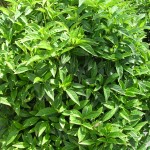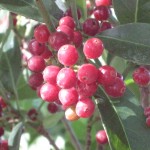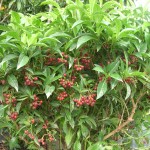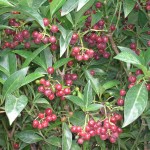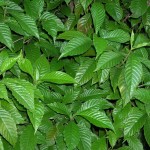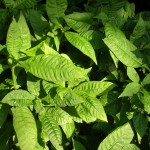Native Florida Coffee Species (Psychotria ligustrifolia, P. nervosa, P. sulzneri)
Since 1958, grower Juan Valdez and his mule, Conchita, have been employed to put us in mind of some of the best coffee in the world. These fictional characters have left an indelible impression on generations of consumers. And right now you might be thinking how nice it would be to stroll through lush fields of coffee in Colombia. But wait. Do you really want to take that long ride to the airport and then stand in line for what seems like hours before you can board the plane? And ticket prices have gotten pretty expensive, too.
Well, here’s an alternative: Did you know that there are four species of wild coffee found in southern Florida? Why not plant some of them in your back yard and become your own coffee grower?
Psychotria ligustrifolia, is commonly known as the Bahama Wild Coffee, but occurs over a larger range — from southern Florida into the West Indies (the Bahamas and the Greater Antilles, but not the Lesser Antilles). While the species is secure in its range, it is considered endangered in Florida. Unlike other species of wild coffee, it is not native to moist forest habitat. Accordingly, when grown in cultivation, care should be taken simply to keep it evenly hydrated. It grows as a medium-sized shrub with shiny, grooved green leaves. It makes a good informal hedge for use as an accent or buffer planting and can adapt to light conditions ranging from fairly deep shade to full sun. It grows more compactly and features darker leaves than P. nervosa. Bahama Wild Coffee produces small white flowers which attract butterflies, followed by red fruit which attracts birds. The birds, as well as other animals, also use this and other wild coffee species for cover. While P. ligustrifolia is related to the coffee of Juan Valdez, it does not produce enough caffeine to qualify it as a substitute.
Psychotria nervosa, commonly known as Wild Coffee, is a medium-sized shrub with shiny, deeply-grooved green leaves about 6 in. long. It is native to lightly-shaded areas in moist forests in a very extensive range from northern Florida into the West Indies, Mexico, Central America, and South America. However, it is quite rare in the lower Florida Keys. It grows at a moderate rate to about 4-6 ft. tall and often about as wide. Once established, the species can tolerate brief droughts. It makes a good informal hedge for use as an accent or buffer planting and can adapt to full-sun exposures. P. nervosa, the most widely-cultivated wild coffee, prefers moist limestone or sandy soils with a humusy upper layer. Good organic content will help it thrive, but it can tolerate nutrient-poor soils. Saltwater spray is not tolerated, but it can grow near the coast if protected by other vegetation. The plant produces fairly showy white flowers followed by red fruit — safe for human consumption —which looks much like the true coffee bean.
Birds and other animals also enjoy eating the fruit of Wild Coffee. In addition, P. nervosa is a nectar source for several butterflies, including the Atala (Eumaeus atala), not long ago on the brink of extinction.
P. nervosa has historically been, and continues to be, used for medicinal purposes. Hundreds of years ago, it was employed as a treatment for dysentery. In modern times in the West Indies, Mexico and South America, it is used to stop bleeding, to reduce fever, and to treat colds, asthma, swollen feet, stomach aches, and dermatological maladies.
Psychotria sulzneri, the Shortleaf Wild Coffee, is a medium-sized shrub with dull green leaves. It is native to lightly-shaded areas in moist forests and swamps in a fairly large range from Central Florida into the West Indies, Mexico, and Central America. It grows at a moderate rate to about 3-4 ft. tall and about as wide. Once established, the species can tolerate brief droughts. Like P. nervosa, it makes a good informal hedge for use as an accent or buffer planting. P. sulzneri prefers moist limestone or sandy soils with a humusy upper layer. Good organic content will help it thrive, but it can tolerate nutrient-poor soils. Saltwater spray is not tolerated, but it can grow near the coast if protected by other vegetation. The plant produces nondescript green flowers followed by red, orange or yellow fruit.
Birds and other animals eat the fruit of this species. Like P. ligustrifolia and P. nervosa, it is also a nectar source for the Atala Butterfly.
P. sulzneri also possesses medicinal qualities. It has been used to reduce fever and otherwise treat colds, as well as to treat asthma, stomach problems, swelling of limbs, tumors, and dermatological problems.
Psychotria punctata, the Dotted Wild Coffee, differs from the other coffee species found in the wild here by virtue of the raised warts, or dots, on the leaf surfaces. They are, more accurately, nodules caused by bacteria. This species is not native to Florida, but rather to southern Africa, and has escaped here. It is little-known in cultivation.
The three Florida native wild coffee species are available at Richard Lyons’ Nursery in 3- and 7-gal. containers. Conchita the mule not included.
